.
25.09.2014
First pictures from Red Planet arrive, Mangalyaan 'doing well'
They are here! Mangalyaan's first offering to India is out in the open.
Indian Space Research Organisation (Isro) released on Thursday the first image of Mars clicked by the indigenous Mangalyaan, which took India to soaring heights a day ago by slipping into the Red Planet's orbit on the country's maiden attempt.
Isro said the photograph — named 'First Light' — it posted on its Facebook page and Twitter account was taken from "a height of 7300 km; with 376 m spatial resolution".
The image showed an orange surface with dark cavities. “The view is nice up here,” Isro said on Twitter.
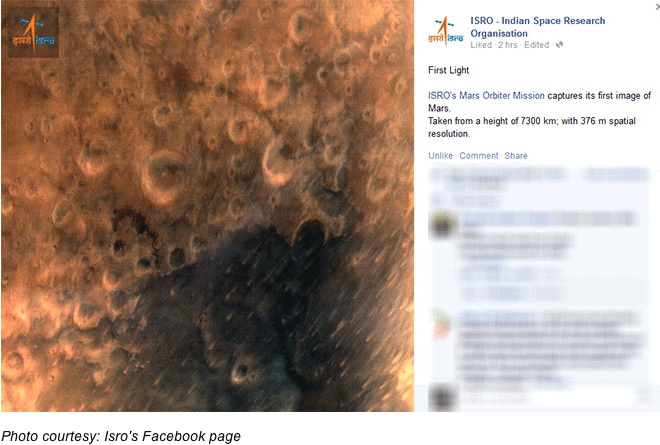
"The Mars Colour Camera (MCC) onboard started working soon after the orbiter stabilised in the elliptical orbit of Mars and has taken a dozen quality pictures of its surface and its surroundings," Isro's scientific secretary V Koteshwara Rao said.
An Isro team led by agency chief K Radhakrishnan met Prime Minister Narendra Modi in Delhi on Thursday with hard copies of all the pictures taken by the Mars Orbiter Mission (MOM) probe.
Speculation is rife that Isro might release them later in the day.
.
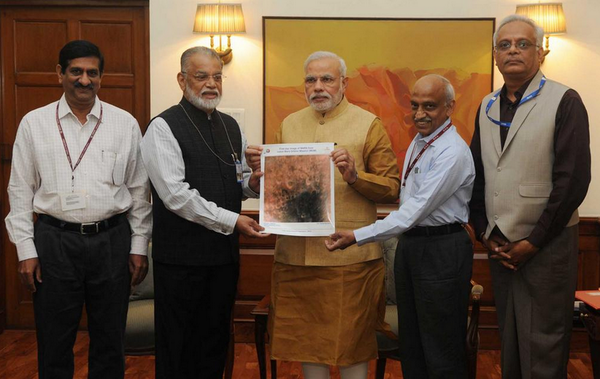
The photographs bear a testimony to the fact that MOM, which helped India join an elite club of successful Mars explorers, is in 'good health' and performing its duties well.
The spacecraft, according to Isro scientists, started sending its first high-quality images of the Red Planet late on Wednesday.
"Images are clicked. Data is downloaded. Process is going on," a top Isro official had told HT, confirming all is well.
The snaps were expected to arrive in the afternoon on the momentous day, but there was no news about them till evening, causing some concerns.
India had joined on Wednesday an exclusive global club of deep space explorers when Mangalyaan successfully entered the orbit around Mars after a 10-month journey on a relatively shoe-string budget.
The probe costs just Rs. 450 core and is about a tenth of the amount US space agency Nasa spent on sending the Maven spacecraft to Mars and about three-quarters the amount to make the Oscar-winning movie Gravity about astronauts stranded in space.
India's probe has been placed in an elliptical orbit around Mars and it will be closest to the planet at 377 km and farthest at 80,000 km.
The 1,350-kilogram orbiter will now circle the planet for at least six months, with solar-powered instruments gathering scientific data that may shed light on Martian weather systems as well as what happened to the water that is believed to have existed once on Mars.
It will also search Mars for methane, a key chemical in life processes on earth that could come from geological processes. None of the instruments will send back enough information to answer these questions definitively, but experts say the data will help them better understand how planets form and what conditions might make life possible.
Quelle: Hindustan Times
.
Indian mission on Mars beams back first photos
India's Mars Orbiter Mission has beamed back its first pictures from space. The blurred images show the pock-marked surface of the red planet.
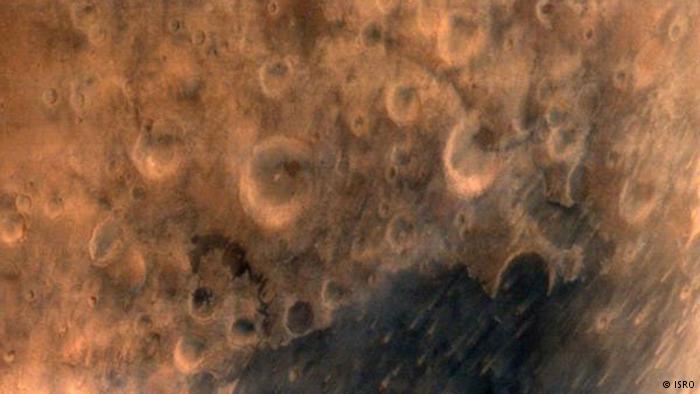
The Indian Space Research Organization (ISRO) uploaded one of the pictures on its Facebook and Twitter accounts. India's Mars Orbiter Mission, also known as the Mangalyaan, took the pictures from a height of 7,300 kilometers (4,536 miles).
The Indian space agency captioned the picture with the words "First Light." It also posted images of Indian Prime Minister Narendra Modi formally releasing the pictures together with space agency scientists.
ISRO's Mars Orbiter Mission, which seeks to find evidence of life on Mars, cost the Indian government $ 74 million compared to NASA's $ 671 million MAVEN spacecraft, which began orbiting Mars on Sunday.
India's mission on Mars has been a source of pride for the country, which is the first in Asia to launch a space mission. India beat China despite Beijing's billion-dollar attempt to launch a mission to the red planet in 2011.
New Delhi joins an elite club of the United States, Europe and Russia, which have successfully launched space campaigns to earth's neighbor.
Quelle:DW
.
Update: 26.09.2014
.
Meanwhile, the Mars Orbiter Mission — also known as MOM or Mangalyaan (Hindi for "Mars-Craft") — got right to work after Tuesday night's orbital insertion. One color picture shows Mars and a thin layer of its dust-laden atmosphere, as seen from an altitude of 5,250 miles (8,449 kilometers). Another photo captures a view of Mars' cratered surface from a height of 4,500 miles (7,300 kilometers).
ISRO
The color camera aboard India's Mars Orbiter Mission spacecraft shows the thin layer of Mars' dust-laden atmosphere on the edge of the planet's disk, as seen from an altitude of 8,449 kilometers.
MOM's months-long study of Martian atmosphere, weather and mineralogy will complement Maven's observations. MOM's instruments are better-suited for detecting whiffs of methane, which have sparked a big question for astrobiologists: Is that methane strictly geological in origin, or could it hint at biological activity?
The findings from MOM and Maven will help flesh out our understanding of the Red Planet, adding to the scientific riches already being provided by the European Space Agency's Mars Express orbiter and NASA's Curiosity and Opportunity rovers, as well as Mars Reconnaissance Orbiter and Mars Odyssey.
.
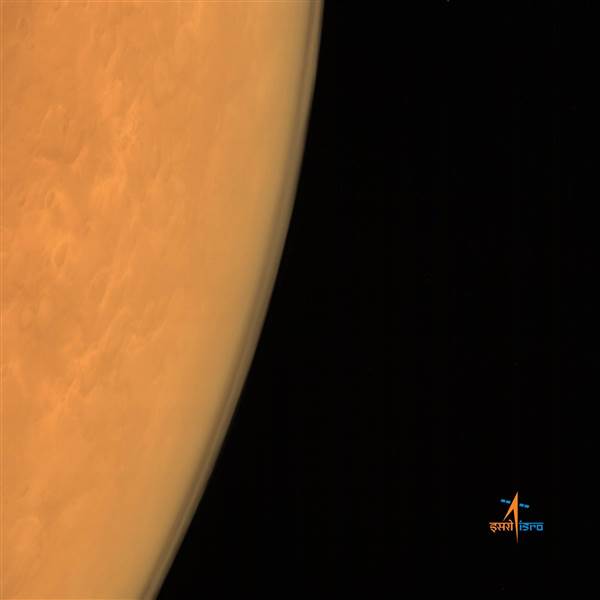
Quelle: NBC
.
Update: 19.09.2014
Mangalyaan begins its science mission
Three days after flashing five images of the Martian atmosphere, India's maiden spacecraft to Mars jump-started its main science mission-- with two of its payloads becoming operational on Sunday morning.
India had entered an elite space club when its spacecraft entered the Red Planet on September 24.
According to sources in the Indian Space Research Organisation(Isro) both the Methane Sensor for Mars(MSM) and the Thermal Infrared Imaging Spectrometer(TIS) were switched on and the calibration was verified.
The operation was verified for nearly 30 minutes, sources said adding: "The data recovery will begin in the coming days. The other three payloads will also start operating in due course."
The 1,350 kilogram orbiter spacecraft carries five payloads for gathering scientific data that may shed light on Martian weather systems as well as what happened to the water that is believed to have existed once on Mars.
The MSM is designed to measure methane in the Martian atmosphere and map its sources. Data is acquired only over illuminated scene as the sensor measures reflected solar radiations. Methane concentration in the Martian atmosphere undergoes spatial and temporal variations.
The TIS measure the thermal emission and can be operated during both day and night. TIS can map surface composition and mineralogy of Mars.
None of the instruments will send back enough information to answer these questions definitively, but experts say the data will help them better understand how planets form and what conditions might make life possible.
While the scientific instruments will work for 6 months, there is a possibility of its life span exceeding beyond that.
Quelle: hindustantimes
.
Update: 30.09.2014
.
Dusty Days: India Mission Photographs Stormy Mars Globe
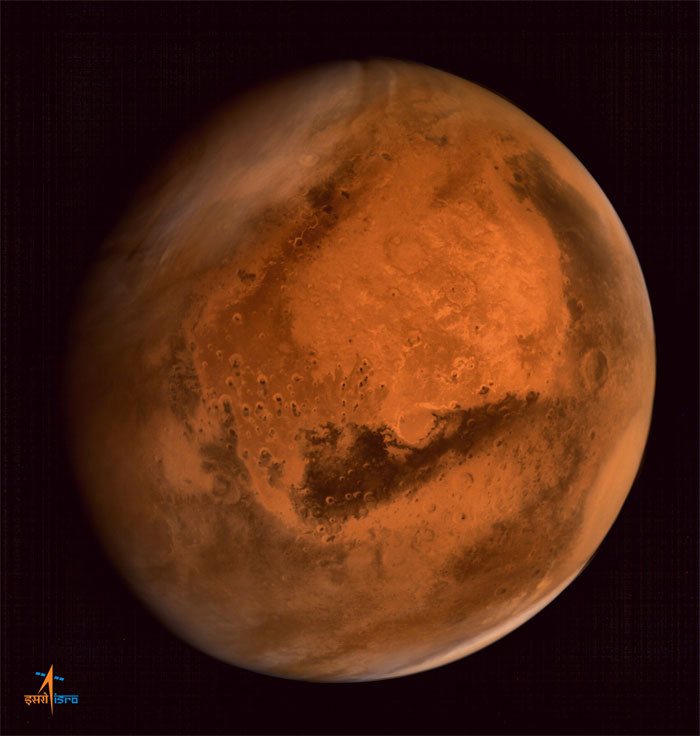
A global photograph of Mars by India's Mars Orbiter Mission (MOM). Click for full resolution version. ISRO/MOM
As soon as India’s Mars Orbiter Mission (MOM) entered orbit around the Red Planet last week, it started snapping the Martian surface and atmosphere, showing the world that we have yet another ace robotic photographer orbiting the planet. Today, the Indian Space Research Organization (ISRO) has released the mission’s first global view of Mars — and in doing so, MOM has done a little Mars weather forecasting: there’s a dust storm brewing.
Imaged at a distance of 74,500 kilometers (46,300 miles) on Sunday (Sept. 28), many of Mars’ familiar features are easy to see. Interestingly, the plain, Meridiani Planum, is dead-center of the shot — the location where Mars rover Opportunity landed in 2004 and continues to explore to this day.
Also, near the top of the image, the greyish clouds are a sign of a dust storm brewing in the northern hemisphere. “Something’s brewing here!” the @MarsOrbiter official Twitter account tweeted on Monday.
As MOM’s orbit is highly elliptical, reaching from 262 miles (periareon — closest approach) to 47,841 miles (apoareon — farthest extent), we can expect a lot more global views from Mars’ newest satellite, providing us with a beautiful global perspective of a planet that currently has seven robotic missions (from three different space agencies) exploring it.
Quelle: D-News
.
Update: 1.10.2014
.
Mangalyaan sends 3D image of Mars
The Indian Space Research Organisation (Isro) on Tuesday uploaded a 3D image of Mars - generated using multiple pictures acquired by Mars Color Camera in the Mars Orbiter Mission (MOM).
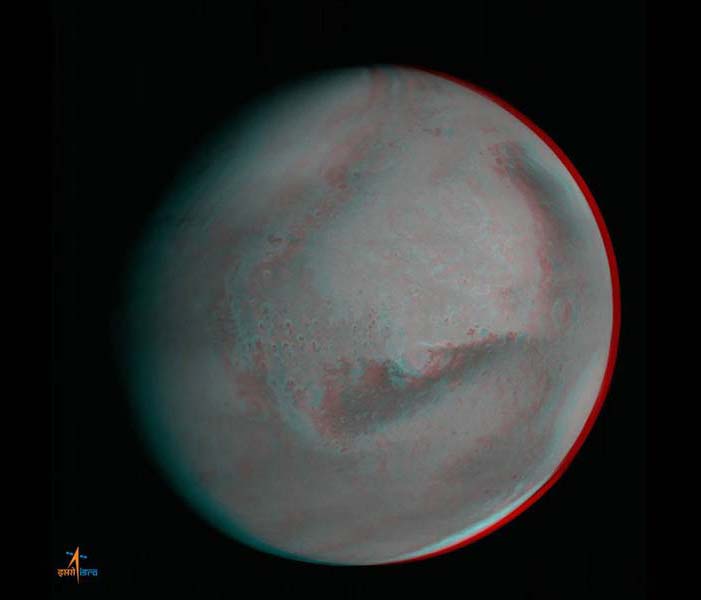
3D image of Mars taken by the Mars Orbiter Mission. (Courtesy: Isro)
India's maiden spacecraft to Mars - MOM had reached the Red Planet on September 24.
"An anaglyph 3D image of Mars - generated using multiple pictures acquired by Mars Color Camera," says the Facebook page of Isro.
But before that Isro also loaded for public an easy way on how to make your own 3D glasses.
On Monday, Isro had uploaded the regional dust storm activities over northern hemisphere of Mars - captured by Mars Color Camera. The image was taken from an altitude of 74,500 km from the surface of Mars.
Quelle: hindustantimes
.
Update: 8.10.2014
.
ISRO's Mars Orbiter - Mangalyaan sends second full-disc colour image of Mars
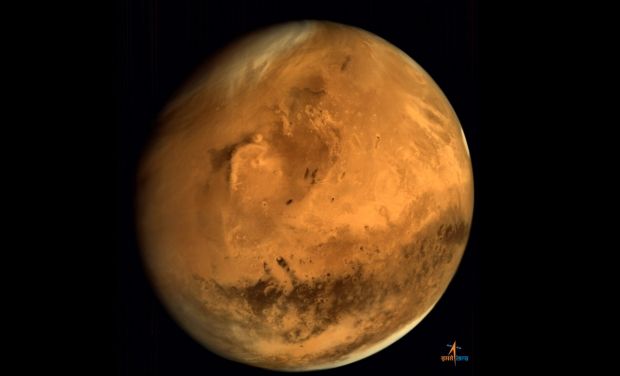
A full-disc Photo of Mars released by ISRO's Mangalyaan spacecraft (Photo Credit: ISRO)
.
Mumbai: ISRO's Mars Obiter Mission (MOM) - Mangalyaan has sent the second full - disc image of Mars. The colour image was clicked by the Mars Colour Camera (MCC) mounted on to the spacecraft.
The photograph was taken from an altitude of 66,543 km, as posted by ISRO's official facebook post. The picture shows the cloud formation on the red planet caused by wind storms. The dark regions to the south of the cloud formation is Elysium - which is the second largest volcanic province on Mars.
Launched of the 5th of November 2013 form India's only space launch facility in Sriharikota; Mangakyaan entered Mars orbit on September 24, 2014. The insertion was conducted by the Spacecraft Control Centre by ISRO’s Telemetry, Tracking and Command Network (ISTRAC), Bengaluru with support from Indian Deep Space Network (IDSN) antennae at Byalalu.
.
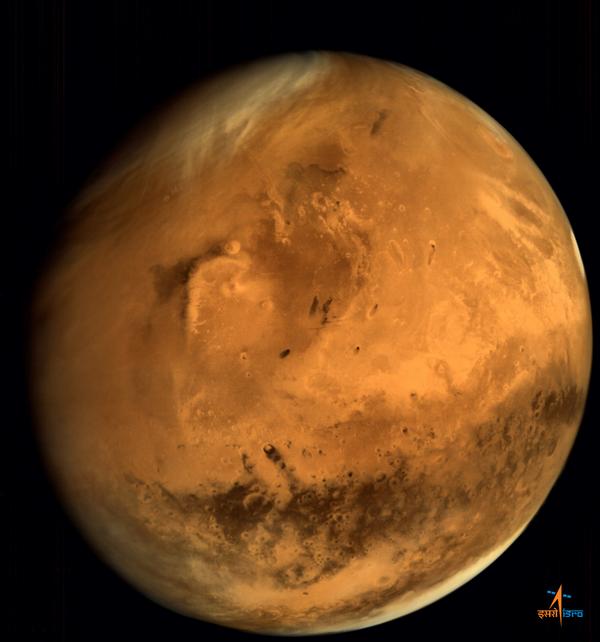
Full disc image from @MarsOrbiter. South of the cloud formation is Elysium- the 2nd largest volcanic province on Mars
Quelle: DECCAN-Chronicle
.
New global Mars image from Mars Orbiter Mission features Gale crater
Posted By Emily Lakdawalla
ISRO has released a second global image of Mars from the Mars Colour Camera on Mars Orbiter Mission, and just below the center of it is Gale crater, home to Curiosity. Gale is easy to spot from its very dark floor forming two horns that cradle Gale's central mountain, and the dark streak that runs out of the crater toward Terra Cimmeria to the south. Gusev crater, and the silent Spirit rover, are also in the photo -- look at the context map below to help you pick it out.
.
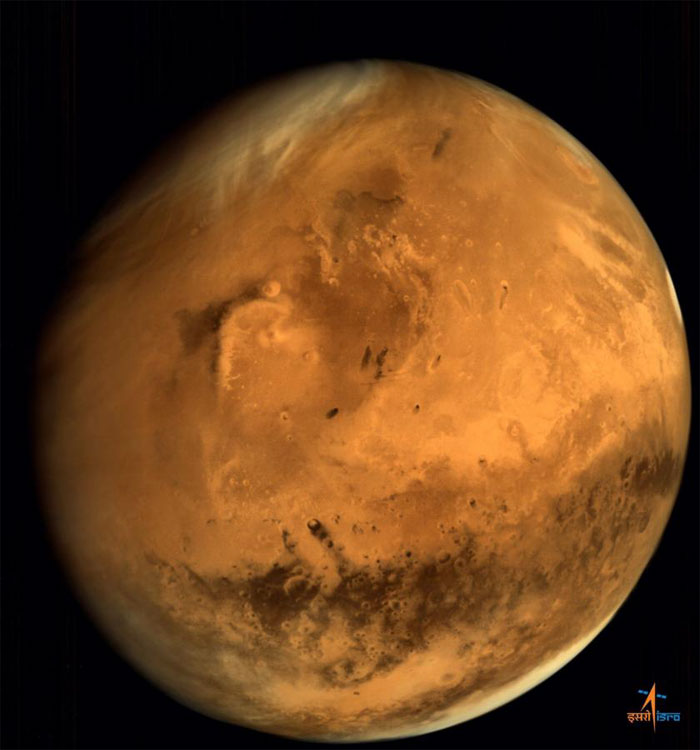
Mars from Mars Orbiter Mission, with Elysium and Gale
Mars Orbiter Mission captured this view of Mars from a distance of 66,543 kilometers. The view includes the large Elysium volcanic region on Mars, and the dark swath of Terra Cimmeria across the disk to the south. Near the center of the disk is a small crater that has a large dark streak running down from it: that is Gale, home to Curiosity.
Here's a screen cap from the Mars Globe app to help you find your way around the image. The global view doesn't look quite the same because Mars Globe is simulating the view from significantly closer -- about 7000 kilometers away -- so there are features that disappear around the edges of the disk on the Mars Globe simulation that are visible on the disk in the much more distant Mars Orbiter Mission photo. (In particular, in the photo above you can see the great shield of Olympus Mons right at the edge of the disk at upper right, but it's not visible in the map below because the viewpoint is too close.)
.
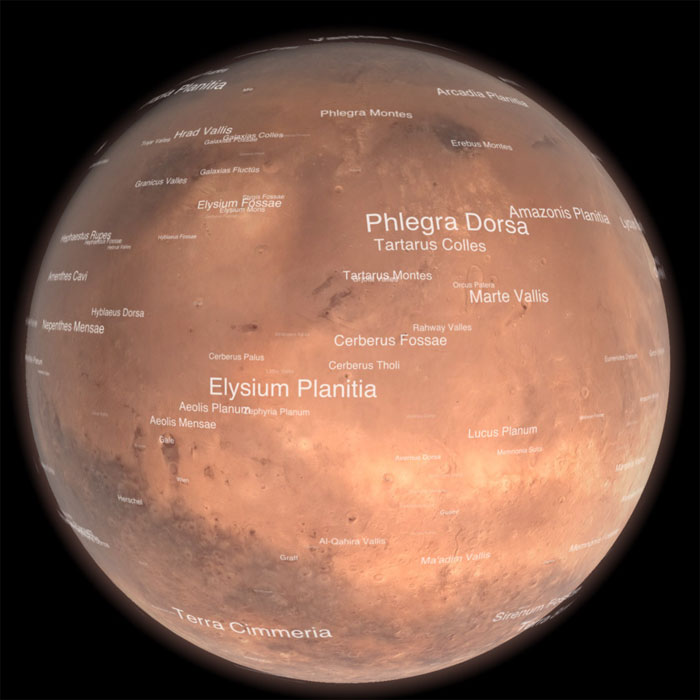
Mars Globe / Michael Howard
Mars from Mars Orbiter Mission, with Elysium and Gale (context map)
Screen capture from the Mars Globe App.
This newly released global view of Mars is distinctly less red than the first one that came out of the mission a week ago. When a spacecraft first turns on its instruments, it may take a while to get the calibration right. It's been interesting to watch space enthusiasts on the Internet fiddle with the color in the first image in order to produce something that looks more pleasing to them. Most people agree that the original was too red (or, more precisely, that the blue channel was far too dark), but different people have produced different results based upon their judgment of what Mars should look like. Here are eight slightly different views of that one image of Mars:
.

Eight takes on a global view of Mars
The first global image of Mars released by the Mars Orbiter Mission is at lower right. Most space fans thought it looked too red, and processed it to produce a more pleasing-looking Mars. The seven views shown here were processed by (top row, left to right): Björn Jónsson, Don Davis, Elisabetta Bonora and Marco Faccin, and Fred Calef; (bottom row, left to right): Judy Schmidt, Olivier de Goursac, and Ted Stryk.
I assume we'll be seeing some nicely processed versions of the new photo from the amateur community -- I'll post one here when I see one I like!
Quelle: planetarySociety
.
Update: 14.10.2014
.
Mangalyaan to witness comet fly-by
India's Mars Orbiter Mission (MOM) spacecraft 'Mangalyaan', that has recently started orbiting the Red Planet, is getting ready to witness a unique cosmic event. On 20th October, Mangalyaan, which is millions of kilometers away from earth, will be privy to an astronomically significant fly-past of Comet Siding Spring.
MOM will duck for cover behind Mars, like the NASA missions there, and might capture and send photos of those moments back to earth.
Siding Spring is passing through the solar system for the very first time and that it will approach Mars at a tenth of the distance any comet has visited Earth, stargazers said.
According to ISRO, the comet's fly-by is both a hazard and a spectacle. As it departs, the comet's huge dust trail can potentially wreak havoc on the sensitive electronic devices of earthly spacecraft and disable them.
As per MOM Mission director V. Kesava Raju, ISRO engineers from the command centre at Bangalore are trying to balance MOM's safety with the visual treat the fly-by promises.
He further added that the team of engineers associated with the 5 MOM instruments was working out the best position for the instruments for the October 20 event.
Possibilities to take photos of Siding Spring and its tail during October 19 ? 21 are also under discussion. However, the main concern would be to protect the spacecraft's body from exposure to the massive cloud of dust.
Quelle: DDN
.
Update: 15.10.2014
.
Isro’s Orbiter spots mars moon Phobos
Almost 20 days after it successfully entered the orbit of the red planet, Isro’s Mars Orbiter on Tuesday sent pictures of Phobos — the largest of the two natural satellites that orbit around Mars.
The Isro, the national space agency, has shared a tiny footage on its social networking site with a caption, “The larger of the two Martian moons, Phobos, is seen travelling west to east over Mars in its typical orbit.”
The images were taken from an altitude of 66,275 km above the surface of the red planet, it said. Phobos, along with the Mars’ another natural satellite Deimos, was discovered by mankind in 1877. According to the Nasa, Phobos, which is 27 by 22 by 18 km in diametre orbits the red planet three times a day. Phobos was nearing Mars at a rate of 1.8 m every hundred years and at that rate, it would either crash into the red planet in 50 million years or break up into a ring, according to the US national space agency.
Quelle:TAA
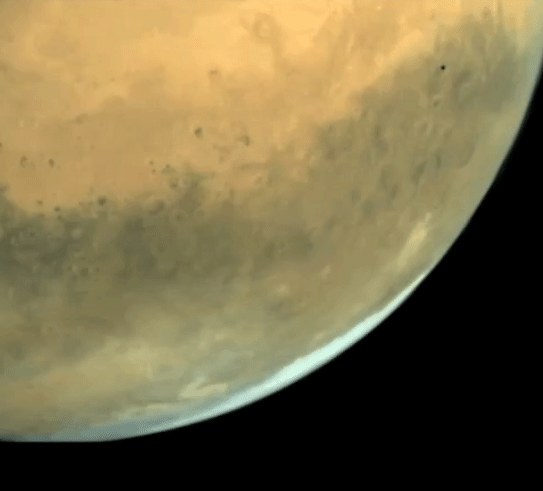
.
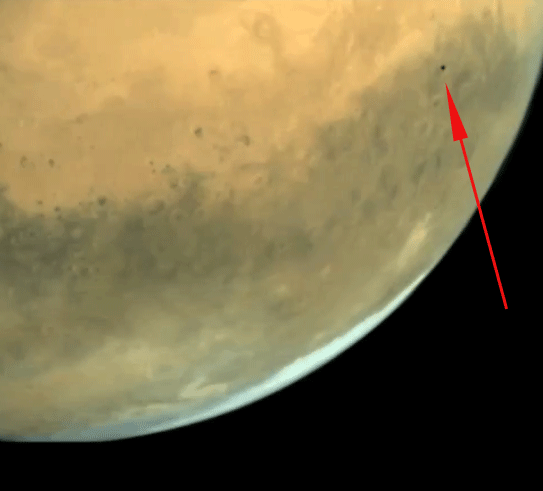
Quelle: ISRO
.
Update: 6.11.2014
.
MUMBAI: The Mars Orbiter Mission (MOM) has kicked off its science phase and its five payloads are gathering data in full swing, said director of Isro's Space Application Centre, Kiran Kumar.
The MOM entered the Martian orbit on September 24 and made history by achieving success on its maiden flight. Google celebrated the first month the orbiter's entry to Mars with a doodle on October 24.
Speaking to TOI on Wednesday, which marked the first anniversary of the MOM launch on November 5, 2013, Kumar said the data downloaded from the spacecraft at the Indian Deep Space Network in Byalalu, off the BangaloreMysore highway, is being transmitted to the principal investigators for analysis.
Kurian Mathew, principal investigator of the Methane Sensor For Mars, said: "We are analyzing data from both from Mars and comet Siding Spring. We will highlight them at an appropriate moment."
The Methane Sensor For Mars has been described as the "bridegroom" of all the payloads as its findings are expected to have huge ramifications. Indian Space Science Data Centre's general manager J D Rao could not hide his excitement. "We are anxiously waiting for the results," he told TOI on Wednesday.
The quality of the pictures taken by the Mars Colour Camera in the last one-and-half month has attracted considerable praise from across the world. However, for some unexplained reason the first anniversary of MOM's launch on Wednesday remained a quite affair with no mention of it in Isro's Facebook and Twitter accounts.
Quelle: The Times of India
.
Update: 17.12.2014
.
Komet Siding-Spring C2013-A1
.
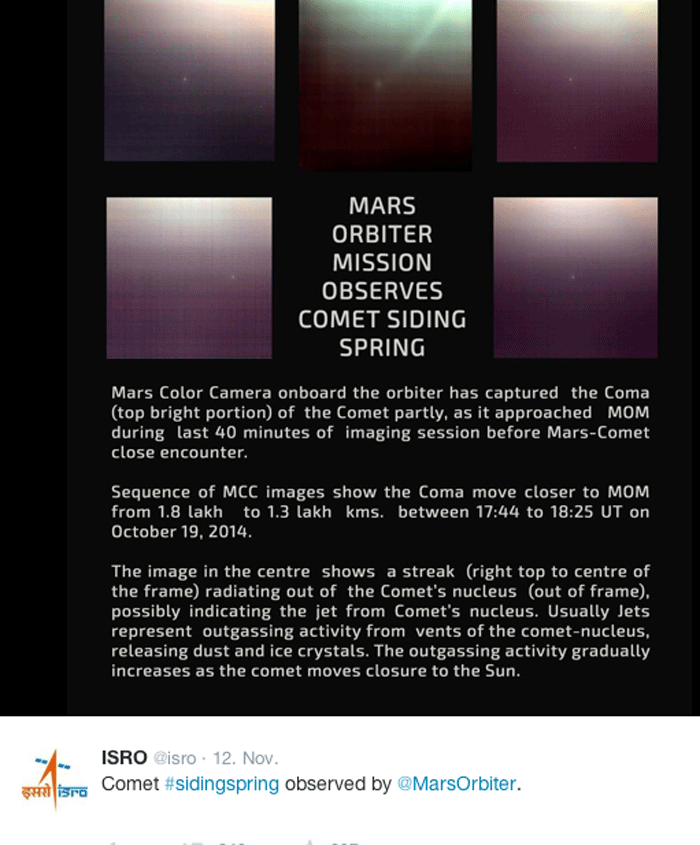
Quelle: ISRO
-
Siehe zu Komet Siding-Spring auch:
/_blog/2014/11/03/astronomie---mars-besuch-von-komet-siding-spring-c2013-a1-im-oktober-verspricht-gute-beobachtungsmoeglichkeiten/
.
Update: 25.12.2014
.
Mangalyaan completes three months in Mars orbit
India's maiden mission to Mars, Mangalyaan, completes three months in Mars orbit on Wednesday and will continue in orbit beyond the six months that was initially planned.
On September 24, India created history by becoming the first country to succeed on its first Mars mission when Isro's Mangalyaan slipped into Martian orbit.
The country joined the United States, European Space Agency and the former Soviet Union in the elite club of Martian explorers with the Mars Orbiter Mission, affectionately called MOM.
In the last three months, Mangalyaan has captured nearly 300 pictures. On an average the spacecraft takes four pictures in three days. Besides capturing the images of dust storm activities, it has also taken images of comet Siding Spring.
The images are being analysed by Isro scientists.
"All systems of the spacecraft are functioning well. Since fuel is not a constraint, the spacecraft is expected to stay in the Martian orbit for more than six months," Dr Kiran Kumar, director, Space Application Centre told HT.
"The process of analysing the data is going on. We need one complete cycle to arrive at some conclusion."
The next challenge for the spacecraft will be in June next year when all three - Mars, Earth and Sun - will be in one line. "There will be no communication with the spacecraft for 14 days."
The distance between Earth and Mars is gradually increasing. At the time of Mars insertion, the spacecraft was 250 million km from the Earth. This will gradually increase to 390 million km when Mars is at its maximum distance from Earth.
Quelle: hindustantimes
-
Update: 4.01.2014
.
For 15 days in June, sun to block all communication with Mangalyaan
MUMBAI: There will be a nail-biting fortnight in June for the Isro team because there will be absolutely no communication with the Mars Orbiter Mission (MOM) during that period.
"It [communication break] will be for the first time for such a long period since its launch on November 5, 2013," former Isro chairman K Radhakrishnan said at the Indian Science Congress on Friday.
In a question-and-answer session with former Isro scientist Pramod Kale at the first plenary meeting of the 102nd edition of the congress, Radhakrishnan said that the blackout will be the result of an eclipse.
MOM project director Subbiah Arunan, who is scheduled to address the congress on Monday, said the blackout will be from June 8 to 22 because the Sun will come between Earth and Mars, blocking the view of the Red Planet.
Arunan said that during the blackout data cannot be transmitted to the spacecraft or downlinked. "MOM will be fully in autonomous mode," he said.
Arunan said the scenario had been tested in the mission simulation tests.
"There have been many manoeuvres when there has been a communication blackout, but this is the first time it is happening for as long as 14 day," Arunan said. "We are confident that there will be no problems."
Arunan said in May 2016 there will be what is known as a "whiteout" period when Earth will come between the Sun and Mars, blocking communication with the spacecraft for about a fortnight again.
Radhakrishnan, who retired on Wednesday, told the large gathering of students and scientists that the quality of data downloaded from the five payloads on board MOM was excellent. "After a series of reviews, they will get published," he said.
Moving to other matters, he said the cryogenic stage for the new LVM 3 rocket would be ready in two years and will be three times more powerful than the existing ones.
He said that 300 industrial firms were participating in the space programme and that in the next few years "we want a launcher like the PSLV coming out of an industry".
About the participation of students in the space programme, Radhakrishnan said they were looking for centres of excellence in space technology in the academic world. To a question about the human space flight programme, he said some more developments had to take place before the country could declare itself ready for such a mission.
Quelle: The Times of India
6405 Views
